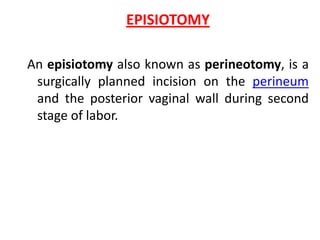
Episiotomy
- 1. EPISIOTOMY An episiotomy also known as perineotomy, is a surgically planned incision on the perineum and the posterior vaginal wall during second stage of labor.
- 2. • Indications • There is a serious risk to the mother of second or third degree tearing • In cases where a natural delivery is adversely affected, but a Caesarean section is not indicated • 'Natural' tearing will cause an increased risk of maternal disease being vertically transmitted • The baby is very large • When perineal muscles are excessively rigid • When instrumental delivery is indicated • When a woman has undergone FGM (female genital mutilation), indicating the need for an anterior and or mediolateral episiotomy • Prolonged late decelerations or fetal bradecardia during active pushing • The baby's shoulders are stuck (shoulder dystocia), or a bony association.
- 3. Types: • Medio-lateral: The incision is made downward and outward from midpoint of fourchette either to right or left. It is directed diagonally in straight line which runs about 2.5cm away from the anus (midpoint between anus and ischial tuberosity). • Median: The incision commences from centre of the fourchette and extends on posterior side along midline for 2.5cm. • Lateral: The incision starts from about 1 cm away from the centre of fourchette and extends laterally. Drawback include chance of injury to Bartholin's duct. It is totally condemned it. • 'J' shaped: The incision begins in the centre of the fourchette and is directed posteriorly along midline for about 1.5cm and then directed downwards and outwards along 5 or 7 o'clock position to avoid the anal sphincter. This is also not done widely.
- 7. Relative merits and demerits of median and medio-lateral episiotomy Median Medio-lateral The muscles are not cut relative safety from rectal Blood loss is least involvement from extension. Repair is easy If necessary, the incision can be Merits Post operative comfort is extended. maximum Healing is superior Wound disruption is rare Dyspareunia is rare Extension, if occurs, may Apposition of the tissues is not involve the rectum. so good. Not suitable for manipulative Blood loss is little more, delivery or in abnormal Post operative discomfort is presentation or position. As such, more its use is selective. Relative increased incidence of Demerits wound disruption Dyspareunia is comparatively more
- 8. • Steps of medio- lateral episiotomy. • Median incisions are believed to be less painful than mediolateral, but when properly repaired there is little difference. Mediolateral incisions are only rarely extended into the rectum and anal sphincter and are often used when more room is required for the delivery process. • A right-handed obstetrician usually incises from the posterior fourchette at the midline toward the patient's left ischial tuberosity. The same structures are separated as with the median incision, and the ischiorectal fossa is exposed. a mediolateral incision has the advantage that it can be extended through the levator ani muscles, expanding the outlet. • A. Incision from midline toward ischial tuberosity. B. Repair of vaginal wall. C. Approximation of leavatores. D. Approximation of bulbocavernosus muscle. E. Reconstruction of urogenital diaphragm. F. Skin closure.
- 9. • the mediolateral episiotomy be performed as a two-step procedure. The first incision is made in the soft tissues of the fourchette and the vagina, followed by incision of the perineum, extending in the mediolateral direction. • Repair is similar to the midline repair. Blood loss can be greater, however, and for this reason repair often is begun before the placenta has been expressed. Before beginning the repair, the rectal mucosa should be palpated for any defects. The vaginal mucosa and underlying supportive tissues are repaired with a running locked suture. The vaginal closure allows reapproximation of the hymenal ring and subsequent anatomical accuracy. • The deep tissues of the perineal body are closed with interrupted fine absorbable suture . Attention made to close the dead space as well as to obtain hemostasis is important, as it is for the median closure. The skin is closed as with the median closure. The Vaginal and rectal examination at the conclusion of the procedure is again important to ensure that no suture has been placed in the rectal mucosa and that the closure is adequate.
- 11. • Post operative care Dressing : the wound is to be dressed each time following urination and defaecation to keep the area clean and dry. Dressing is done by using antiseptic soaked swabs. The attendant should wear a mask while doing dressing. Comfort : to relieve pain in the area, magnesium sulphate compress to be given Analgesic drugs may be given according to instruction. Ambulance: the is allowed to move out of the bed after 24 hours. Removal of stitches : the stitches are to be cut on 6th day.
- 12. Complications Immediate Remote I. Extension of the incision to I. Dyspareunia . involve the rectum. II. Chance of perineal II. Vulval haematoma. lacerations. III. Infection. III. Scar endometriosis (rare). IV. Wound dehiscence.
